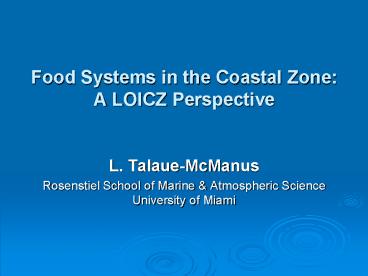Food Systems in the Coastal Zone: A LOICZ Perspective - PowerPoint PPT Presentation
1 / 17
Title:
Food Systems in the Coastal Zone: A LOICZ Perspective
Description:
Food Systems in the Coastal Zone: A LOICZ Perspective L. Talaue-McManus Rosenstiel School of Marine & Atmospheric Science University of Miami LOICZ Structure ... – PowerPoint PPT presentation
Number of Views:73
Avg rating:3.0/5.0
Title: Food Systems in the Coastal Zone: A LOICZ Perspective
1
Food Systems in the Coastal Zone A LOICZ
Perspective
- L. Talaue-McManus
- Rosenstiel School of Marine Atmospheric Science
University of Miami
2
LOICZ Structure
International Network of 3000 Scientists
3
(No Transcript)
4
Nile
5
Nutrient fluxes
Typology To discern Regional Global patterns
Predictive relationships
Nutrient Budget Modeling
6
The LOICZ Typology Environmental Database
World gridded into 259,200 half-degree cells 219
variables, of which 92 are selected oceanic,
atmospheric, geomorphic, terrestrial, human
dimension, special applications all public
domain, with global or near global
coverage. Developmental Partner Biogeography of
the Hexacorallia (www.kgs.ukans.edu/Hexacoral)
- Relevant features
- Selectable geographic regions
- Internet links to Web-LOICZView clustering,
Ocean Biogeographic Information System - Extensive and growing inventory of data
characterization/manipulation tools
7
Predictive relationships (Smith et al., 2003)
- Log (mol DIP km-2 yr-1)
- 2.72 0.36 X log (persons km-2 )
- 0.78 X log (runoff in m3 yr-1)
- DIP load, number of persons, and runoff scaled
to catchment basin area - N168 r2 0.58
8
Nutrients Human-generated and Loads
Parameter (mmol m-2 yr-1) RRD CNP 1000131 Bandon Bay CNP 324271 Lingayen Gulf CNP 106161 Merbok Estuary CNP 140091
DIP generation Agriculture Household 520 78 NA 10 21 14 90 45 53 180 31 NA
DIP load 110 25 65 20
DIN generation Agriculture Household 1,940 76 NA 60 21 15 800 78 20 2,480 28 NA
DIN load 405 1140 425 670
9
Nutrient yield and load to the world
ocean(Estimates for DIP)
- Most of the world coastline still has low yield
- top blue (68 of coastal cells).
- High yield is locally restricted
- top red, yellow (1, 2 of coastal cells).
- Most of the load comes from regions with low to
intermediate yield - bottom red, yellow and white(38, 34, 19 of
load) - top green, white, and blue(20, 9, 68 of
coastline). - Load will continue to grow with population and
land use change.
10
LOICZ II Main Challenge
- Interacting changes in the global CZ are 3-fold
- Global
- Regional (transboundary supra-national)
- Catchment level
- Understanding assisting in the management of
these changes, to ensure the continuity of goods
and services provided by the CZ, IS THE MAIN
CHALLENGE OF A FUTURE LOICZ.
11
(No Transcript)
12
1. River basin deliveries to CZ
- Damming
- Catchment modelling of nutrients and pollutants
- Local governance resource management
- Land use and cover change critical thresholds
of mass transport - Sediment continuum
13
2. Coastal development change
- Coastal urbanization
- Modification of coastal habitats
- Changing deltaic coasts
- Changing sea use (e.g. large-scale engineering,
aquaculture, supplemental energy sources)
14
3. Fate transformation of materials in coastal
shelf waters
- Interaction between changing coastal ecosystems
and biogeochemical functions - Biogeochemical processes and the small food web
- Trace and greenhouse gasses in the CZ
- Coastal zones as CO2 sink or source
- Groundwater seepage
15
4. Vulnerability of coastal systems human safety
- Hard vs. soft coastal defences
- Natural hazards and quality of life
- Climate forcing and harvestable production
- Future of coral reefs
- Sea level rise impacts adaptation
16
Major issues on food systems in the coastal zone
lt
of land surface
Wilson et al in prep.
17
LOICZ Wish List
- Contribute its strengths
- Mobilize its network of scientists
- Realize knowledge products
- Assist local and regional scientific networks to
integrate global environmental change in their
research agenda for the coastal zone































